| Pages:
1
2
3
4 |
AndersHoveland
Hazard to Other Members, due to repeated speculation and posting of untested highly dangerous procedures!
    
Posts: 1986
Registered: 2-3-2011
Member Is Offline
Mood: No Mood
|
|
The actual definition of a clathrate is a crystal lattice structure with completely enclosed cavities, such that guest molecules are
incorporated inside.
The primary being described in this post is more likely just a coprecipitate, or possibly a double salt.
A double salt of this type would contain lead cations, picrate anions, and azide anions, crystallized into a regular crystal pattern.
Basic lead nitrate is the most common double salt. An aqueous solution of lead nitrate reacts with aqueous ammonia to precipitate this white basic
salt, Pb2O(NO3)2.
Another double salt of lead that is known is lead oxalate nitrate.
| Quote: |
This salt is composed of one atom of nitrate of lead, one atom of oxalate of lead, and two atoms of water.
|
[Edited on 16-2-2012 by AndersHoveland]
|
|
|
Rosco Bodine
Banned
Posts: 6370
Registered: 29-9-2004
Member Is Offline
Mood: analytical
|
|
Quote: Originally posted by AndersHoveland  | The actual definition of a clathrate is a crystal lattice structure with completely enclosed cavities, such that guest molecules are
incorporated inside.
The primary being described in this post is more likely just a coprecipitate, or possibly a double salt. |
Your speculation is dubious. Three patents have issued specifically claiming these type compounds as complex inclusion salts. The properties of the
material are consistent with that claim and the absence of atmospheric susceptibility to degradation of the included azide for the inclusion compound
as contrasted with the still present atmospheric susceptibility of lead azide to decomposition when present as a coprecipitate provides good basis for
confidence in the patents claim.
[Edited on 17-2-2012 by Rosco Bodine]
Attachment: US3293091 Complex Salts of Basic Lead Picrate Kenney 1.pdf (768kB)
This file has been downloaded 779 times
Attachment: US3262956 Basic Lead Double Salts of Picric Acid Kenney 2.pdf (235kB)
This file has been downloaded 809 times
Attachment: US3431156 Complex Crystalline Picrate Explosive Kenney 3.pdf (209kB)
This file has been downloaded 1042 times
|
|
|
AndersHoveland
Hazard to Other Members, due to repeated speculation and posting of untested highly dangerous procedures!
    
Posts: 1986
Registered: 2-3-2011
Member Is Offline
Mood: No Mood
|
|
Yes, that does seem to me the most likely possibility.
The structure of a complex inclusion salt would be somewhere between a single semi-amorphous crystalline structure and a coprecipitate.
The lead azide might be imprisoned within the lead picrate, but clathrate would probably not be the appropriate term to use, as it implies an ordered
single crystalline structure holding the contained molecules.
|
|
|
Rosco Bodine
Banned
Posts: 6370
Registered: 29-9-2004
Member Is Offline
Mood: analytical
|
|
There is a glittering reflectivity from crystal faces observable on the wet material in sunlight but that effect disappears with drying which
transitions the appearance to a dull noncrystalline appearance....so it would seem there is a porosity to the material out to the surface and moisture
held there is filling and leveling to the pores which is reflective, but on drying the cratered surface remaining is not reflective. It is a similar
effect as a rain wet sidewalk can be shiny but on drying the irregular surface is not shiny at all.
|
|
|
Hennig Brand
International Hazard
    
Posts: 1284
Registered: 7-6-2009
Member Is Offline
Mood: No Mood
|
|
I was browsing through the following text and came across a section that referenced the Kenney patents. I have made a pdf of that section (from p.49),
as I thought it might be of interest to some.
"Chemical Analysis of Firearms, Ammunition, and Gunshot Residue"
by James Smyth Wallace
Attachment: Kenney Patents mentioned in Firearms Book.pdf (139kB)
This file has been downloaded 685 times
[Edited on 27-6-2012 by Hennig Brand]
"A risk-free world is a very dull world, one from which we are apt to learn little of consequence." -Geerat Vermeij
|
|
|
Hennig Brand
International Hazard
    
Posts: 1284
Registered: 7-6-2009
Member Is Offline
Mood: No Mood
|
|
Producing basic lead picrate reliably has been an issue for me. Today I experimented and came up with what I think are improvements when using the
materials I have.
My lead nitrate is often very acidic. This acidity is mostly from residual nitric acid from production. This acidity can make accurately adjusting the
pH of the reaction mixture very difficult. Since the basic lead picrate synthesis is a pH driven reaction this is a big problem. Today I carefully
dissolved some of my acidic lead nitrate in water, forming a nearly saturated solution, then allowed the solution to slowly cool. The lead nitrate
crystals were collected and given a small rinse with 95% ethanol to remove any acid remaining. Ethanol seemed like a good choice, for one because it
was available but also lead nitrate is very insoluble in ethanol (0.04 g/100 mL @ 20 C). This seemed to work quite well.
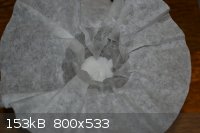
I was having a lot of problems getting the right amount of sodium hydroxide added to produce basic lead picrate. It always ended up being a lot of
guess work, with often less than desirable results. I was never sure if my sodium hydroxide was not as potent as it should be because of moisture or
carbonate contamination, etc or if my picric acid had a contaminant of some sort. Since it takes 2 equivalents of sodium hydroxide for the synthesis,
one to neutralize the picric acid and another to form the basic lead picrate, what was needed was to determine the amount of sodium hydroxide needed
to neutralize the picric acid then double it. It turns out that picric acid can be very easily titrated. I couldn't find my phenolphthalein because a
lot of my stuff is in storage after moving out of an apartment at the end of the last school year. Anyway I used cabbage juice and it worked quite
well. The test tube on the left was water with a little vinegar added, the middle one just water and the one on the right was water with a little
baking soda. All test tubes had several drops of cabbage juice added. These were prepared just for comparison purposes.
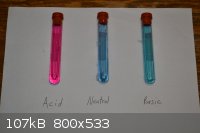
First I accurately weighed out 0.1 g of picric acid and dissolved it in water. An amount of sodium hydroxide in excess of what would be needed for the
titration and the synthesis to follow was measured out and dissolved in water. The 0.1 g of picric acid was titrated to a neutral end point which
allowed determination of the volume of 1 molar equivalent of the sodium hydroxide solution for the basic lead picrate synthesis to follow. The first
picture shows the 0.1 g of picric acid in water solution. The second picture is after the cabbage juice was added. The third picture is at the end
point. It took about 40% more NaOH than what it should have.
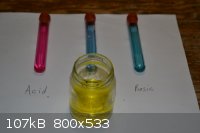 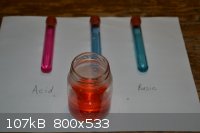 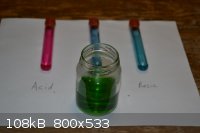
I didn't use heat because it was inconvenient, but I think I probably should have. I think I will try again tomorrow with heat (80 C or so as
suggested in the patent from earlier in this thread). The product does seem to have the right color and properties associated with basic lead picrate
however.
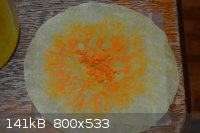
[Edited on 29-7-2013 by Hennig Brand]
"A risk-free world is a very dull world, one from which we are apt to learn little of consequence." -Geerat Vermeij
|
|
|
Rosco Bodine
Banned
Posts: 6370
Registered: 29-9-2004
Member Is Offline
Mood: analytical
|
|
http://www.sciencemadness.org/talk/viewthread.php?tid=389&am...
|
|
|
Hennig Brand
International Hazard
    
Posts: 1284
Registered: 7-6-2009
Member Is Offline
Mood: No Mood
|
|
So basic lead picrate has to be that exact color? I was under the impression that color could vary. I know I have read several places that lead
styphnate can vary in color from sample to sample. That is about the same color as the stuff I made from the last page of this thread as well (the
picture with the several samples together for comparison on the last page of this thread).
Other than using heat I don't know what else I could have done really. I was very careful to use very pure picric acid. Melting point indicated that
it was around 97% pure and then I recrystallized it again from vinegar. The lead nitrate was very carefully recrystallized and then rinsed with
ethanol to remove acidity. Addition was carried out under strong agitation drop by drop over the course of an hour. Reaction mixture was left stirring
after last addition for 30-40 minutes.
"A risk-free world is a very dull world, one from which we are apt to learn little of consequence." -Geerat Vermeij
|
|
|
Rosco Bodine
Banned
Posts: 6370
Registered: 29-9-2004
Member Is Offline
Mood: analytical
|
|
The few times that I have made basic lead picrate the rust color results, and a color shift to the lighter color occurs when that same rust colored
product is converted by further addition to some double salt or clathrate. The initial reaction progress in forming the intended basic lead picrate
may give a mustard yellow intermediate probably indicating a partial hydrate or complex salt of the basic and normal picrate which further develops to
the basic lead picrate end product with sufficient heating and continued stirring for sufficient time. I have accurately reported the reaction
conditions that I used and you are using different conditions and getting a different result and then reporting you are having issues. I don't know
what variables are involved there other than it seems odd that you would be surprised at getting a different result at least in appearance. Color
density can also be related to crystal size so running the reaction cooler will likely shift the color. I got good results running the reaction the
way I wanted to run it, and you are getting something different doing the reaction the way you want to do it. I get this kind of thing all the time.
People change minor aspects of a described process and something different results, and then there is an overreaching conclusion that the report of
the synthesis as described by the original must somehow be in error. I got exactly what I said I got doing exactly what I described and the process
was repeated and confirmed.
The modifications of temperature increase were done for a reason. It was not just for no purpose whatever that I chose to run the reaction at just
under bp instead of the 80C as reported in the patent. Maybe if I had done the reaction at 80C then the product would have looked like mustard
instead of rust, but I did not run the reaction at 80C, but hotter just below othe bp, and the rust colored product is what I got. Quicksilver and
others have done the same thing and gotten the same product. So I have complete confidence the reaction works as described to produce the rust
colored product as described. What is the algebra involved in the changed conditions or materials issues that are causing you to get a different
result I do not know.
When the color is right it will be time to party 
http://www.youtube.com/watch?v=mqGgiaMknzM
[Edited on 29-7-2013 by Rosco Bodine]
|
|
|
Hennig Brand
International Hazard
    
Posts: 1284
Registered: 7-6-2009
Member Is Offline
Mood: No Mood
|
|
OK, fair enough. I just went back to the last page of this thread and had a closer look at your process (which I had forgotten about). You use less
than half the water than the patent method calls for and higher temperature too. Higher concentration means higher pH which should account in large
part for the darker color (I think). Yes I guess I am finally going to have to give your method a try.
I have tried many different samples of picric acid, and learned to test its purity and refine the purification processes. I have learned to produce
good quality lead nitrate low in hydroxide and oxides and acidity. Learned that titrating picric acid is very easy and many other things that I can't
think of right now. All of this because of some pathological inability to follow instructions unless I completely understand why I am doing what I am
doing. Well at least I learned a few things in the process. Well at least I learned a few things in the process.
If I have enough material here, and I think I do, I am going to try your method tomorrow. Man this feels more like some kind of analytical work than
synthesis. Very precise stuff! 
The truth is when you posted your method on the last page, back in 2011, I was so caught up in trying to rationalize what was going on that I paid
very little attention to comparing your method to the patent method. I guess I assumed that basic lead picrate was basic lead picrate and either
method should get me there. I guess there is basic lead picrate and then there is basic lead picrate.
[Edited on 30-7-2013 by Hennig Brand]
"A risk-free world is a very dull world, one from which we are apt to learn little of consequence." -Geerat Vermeij
|
|
|
Rosco Bodine
Banned
Posts: 6370
Registered: 29-9-2004
Member Is Offline
Mood: analytical
|
|
You wanted to pick my brain a bit, which may be something like an archaeo-logical / psycho-logical / cave exploring dig........dig 
http://www.sciencemadness.org/talk/viewthread.php?tid=501&am...
http://www.sciencemadness.org/talk/viewthread.php?tid=2827&a...
http://www.youtube.com/watch?v=WOE1-2Fza5Q
http://www.youtube.com/watch?v=UBbzG7HdAz0
|
|
|
Hennig Brand
International Hazard
    
Posts: 1284
Registered: 7-6-2009
Member Is Offline
Mood: No Mood
|
|
See anything you like?
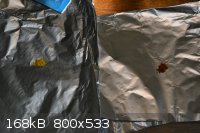
[Edited on 1-8-2013 by Hennig Brand]
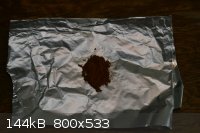
"A risk-free world is a very dull world, one from which we are apt to learn little of consequence." -Geerat Vermeij
|
|
|
Rosco Bodine
Banned
Posts: 6370
Registered: 29-9-2004
Member Is Offline
Mood: analytical
|
|
Can't really tell for sure against the foil. A piece of white paper is best for seeing the color contrast.
Revisit your post about lead styphnate and the scenario for basic lead picrate is similar but the color is not as deep for the basic lead picrate
which is still brown but not as dark and is a duller brown, having not as much red hue as styphnate.
http://www.sciencemadness.org/talk/viewthread.php?tid=2827&a...
|
|
|
Hennig Brand
International Hazard
    
Posts: 1284
Registered: 7-6-2009
Member Is Offline
Mood: No Mood
|
|
Same sample as above but on white paper this time. I just happened to have the sample on aluminum foil previously, but yeah it does make it much
easier to compare colors on a white background.
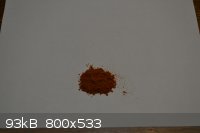
[Edited on 1-8-2013 by Hennig Brand]
"A risk-free world is a very dull world, one from which we are apt to learn little of consequence." -Geerat Vermeij
|
|
|
Rosco Bodine
Banned
Posts: 6370
Registered: 29-9-2004
Member Is Offline
Mood: analytical
|
|
That looks good. Who told you how to do that? 
|
|
|
Hennig Brand
International Hazard
    
Posts: 1284
Registered: 7-6-2009
Member Is Offline
Mood: No Mood
|
|
You know I cheated of course.
I was so sure that it was a pH issue, but it’s not it’s a water of crystallization issue. I don't have access to my corning stirrer hotplate
because it is in storage somewhere, so I had to improvise with some junk I had lying around here. The improvised hotplate stirrer was made a few years
ago for making TNP before I got a commercial stirrer. The water bath has a Pyrex bowl with a 200 W immersion heater. I was only able to keep the
temperature up to 60-70 Celsius with this arrangement.
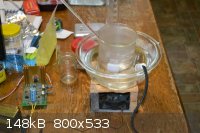
I have learned that in order to lose the water of crystallization the temperature had to be kept very near to 100 C, and even then it was slow
removall. Well I used the method from the patent and of course like every other time that mustard yellow material was produced with much poorer
performance than the rust colored material. This time however once dry it went in the oven, on aluminum foil, at 300 F. In less than a minute it
darkened right up to the rust color. I left it in for 10 minutes or so, just in case more water would be removed. Performance was greatly improved. It
now makes DDT in small amounts and is much more impact sensitive. Here is a picture of a sample made by the patent method before and after going in
the oven. I guess I put them in reverse order for the picture, but you know which is which.
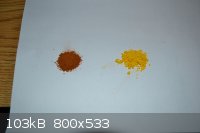
This related journal abstract caught my eye. It is all about lead picrates and it looks like interesting reading. I am thinking of getting the
university to bring it in so I can have a look at it.
Attachment: Synthesis and Properties of Lead Picrates (abstract).pdf (87kB)
This file has been downloaded 872 times
Notice the highlighted part. It is very likely that at 95-100 Celsius the reaction mixture is very near the minimum temperature needed to remove the
water of crystallization from the basic lead picrate. The water comes off in seconds however in a 300 F oven.
I am going to do it your way too once I locate my hotplate stirrer, or think of a better way of heating the stirred reaction mixture in the short
term.
[Edited on 2-8-2013 by Hennig Brand]
"A risk-free world is a very dull world, one from which we are apt to learn little of consequence." -Geerat Vermeij
|
|
|
Rosco Bodine
Banned
Posts: 6370
Registered: 29-9-2004
Member Is Offline
Mood: analytical
|
|
That's interesting about the hydration. I did not know for sure that the basic picrate would even form a hydrate of lighter yellow color, though I
may have speculated about that. I do know the normal picrate forms a bright yellow hydrate which upon dehydration by boiling hot xylene keeps the
same color and crystalline appearance, visually you can't tell the hydrate from the anhydrous form for the normal picrate. But the basic picrate is
another story huh where a color shift occurs on dehydration, if your experiments are reliable in showing that is what has occurred, it could be useful
for something. The hydrate must be only quasi stable and not easily reversible both directions. The low solubility and non hygroscopic nature of the
anhydrous form disinclines it to revert to the hydrated form.
[Edited on 2-8-2013 by Rosco Bodine]
|
|
|
Hennig Brand
International Hazard
    
Posts: 1284
Registered: 7-6-2009
Member Is Offline
Mood: No Mood
|
|
I am glad that I understand this better now. It was maybe starting to become an unhealthy obsession.  I now understand why temperature control, specifically keeping the reaction temperature as close to 100 Celsius as
possible, is of primary importance. I now understand why temperature control, specifically keeping the reaction temperature as close to 100 Celsius as
possible, is of primary importance.
As I was writing this something kind of scary happened. I was being very careful the first couple of times I have dehydrated the basic lead picrate to
carefully preheat the oven before putting the sample in. This time however I didn't and I turned it to 350 F instead of 300 F. I had about a 2g sample
in the oven. Anyway 3 or 4 minutes after placing the sample in the oven and setting the oven to preheat I am sitting 2 rooms away typing this post
when I hear this huge bang and the sound of the oven door slamming open. Oh shit, that can't be good! Luckily on inspection there looks to be very
little damage and thankfully I was the only one home. I opened a door at both ends of the house to air the place out. Here is a picture of what I saw
when I went to see what had happened.
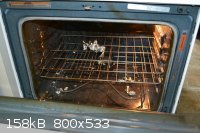
edit:
On closer inspection the oven is in fact damaged. All the walls of the oven have a big bow in them now to the point that the racks don't fit anymore.
This will be difficult to explain to the lady of the house. I guess I can take the oven apart and bend them back; after all it is just enamel coated
sheet steel.
The picture below shows the amount of bend in the bottom of the oven. The sample was placed approximately dead center of the oven.
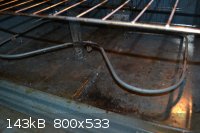
[Edited on 2-8-2013 by Hennig Brand]
"A risk-free world is a very dull world, one from which we are apt to learn little of consequence." -Geerat Vermeij
|
|
|
Praxichys
International Hazard
    
Posts: 1063
Registered: 31-7-2013
Location: Detroit, Michigan, USA
Member Is Offline
Mood: Coprecipitated
|
|
Good thing it wasn't a toaster oven. It would have been obliterated! I suggest giving the interior of that oven a thorough cleaning because of its
newly-increased lead content.
Forgive me for my intrusion but I would very much like to express how much I have enjoyed this thread so far.
[Edited on 2-8-2013 by Praxichys]
|
|
|
Hennig Brand
International Hazard
    
Posts: 1284
Registered: 7-6-2009
Member Is Offline
Mood: No Mood
|
|
A good wash down is probably a really good idea. It seemed that most of the products of detonation blew out into the room right away. However,
cleaning the oven is still a good idea. Glad you like the thread.
"A risk-free world is a very dull world, one from which we are apt to learn little of consequence." -Geerat Vermeij
|
|
|
plante1999
International Hazard
    
Posts: 1936
Registered: 27-12-2010
Member Is Offline
Mood: Mad as a hatter
|
|
I guess it was a good lesson: Do not cook primary explosives in the house oven anymore.
I never asked for this.
|
|
|
Hennig Brand
International Hazard
    
Posts: 1284
Registered: 7-6-2009
Member Is Offline
Mood: No Mood
|
|
Or at least make sure to preheat the oven first so as to avoid a temperature spike which is high enough to reach the ignition temperature of the
sample.  
Actually there may be no need of going quite that hot anyway. It was just an experiment. I suppose an oil bath would allow one to raise the
temperature up over 100 C and would probably do the trick.
edit:
BTW, I just finished taking the panels off the oven and carefully bent back the sides of the oven interior walls. I also gave it a good wipe down
inside with a vinegar-water mixture. Everything is more or less back to rights. Really the internal pressure generated wouldn't need to be that great
to bend the sides since the sheet metal sides are quite large in area and thin. Not preheating the oven was foolish, but at least I was smart enough
to only put 2 g in there and was able to return the oven to close its original condition.
[Edited on 2-8-2013 by Hennig Brand]
"A risk-free world is a very dull world, one from which we are apt to learn little of consequence." -Geerat Vermeij
|
|
|
Hennig Brand
International Hazard
    
Posts: 1284
Registered: 7-6-2009
Member Is Offline
Mood: No Mood
|
|
I recently experimented using lower temperatures to dehydrate (if that is what is happening) the mustard yellow basic lead picrate made by the patent
method. I started testing at just over the boiling point of water and moved up at 10 degree Fahrenheit increments. It looks as though 300 F is
actually at the bottom end of where the material seems to darken and actually a higher temperature of 350 F seems to do a better job of conversion.
The change that takes place seems to be permanent, or at least the few samples I have, have stayed the same for the last few days. What I should have
done is taken the weight of a sample before and after to see if the numbers supported the theory of dehydration. I will try and remember to take
weights before and after the next time.
"A risk-free world is a very dull world, one from which we are apt to learn little of consequence." -Geerat Vermeij
|
|
|
Rosco Bodine
Banned
Posts: 6370
Registered: 29-9-2004
Member Is Offline
Mood: analytical
|
|
FWIW what you are doing is a radical departure from the process I described and to do something like what you are doing is exploring an unknown that
is risky. Having included azide and nitrate in the compound and proceeding with this bakeout scheme would be a bad idea IMO. Better to make the
target compound in near boiling aqueous reaction mixture as described.
|
|
|
Hennig Brand
International Hazard
    
Posts: 1284
Registered: 7-6-2009
Member Is Offline
Mood: No Mood
|
|
I wasn't thinking of adding azide and then cooking the compound in the oven. This was more of a way to satisfy my curiosity about what was happening
with the basic lead picrate. It is agreed that this practice even with basic lead picrate alone is a bit risky, however when the sample size is kept
small the risk can be within reason (in my opinion). Don't worry when I try for a clathrate I will go with your method.
When using your method keeping the temperature as close to boiling as possible, and of course giving the reaction the time it needs, seems to be the
key. I was thinking of using a flask and putting a reflux condenser on it (section of glass tubing maybe for an air condenser) which would allow
staying at the boiling point without losing as much water to evaporation and making it easier to keep the temperature maximized. What do you think?
A vessel that would allow increasing the pressure would allow raising the boiling point (pressure cooker). This is not needed I guess. Just thought
I'd mention it.
[Edited on 7-8-2013 by Hennig Brand]
"A risk-free world is a very dull world, one from which we are apt to learn little of consequence." -Geerat Vermeij
|
|
|
| Pages:
1
2
3
4 |